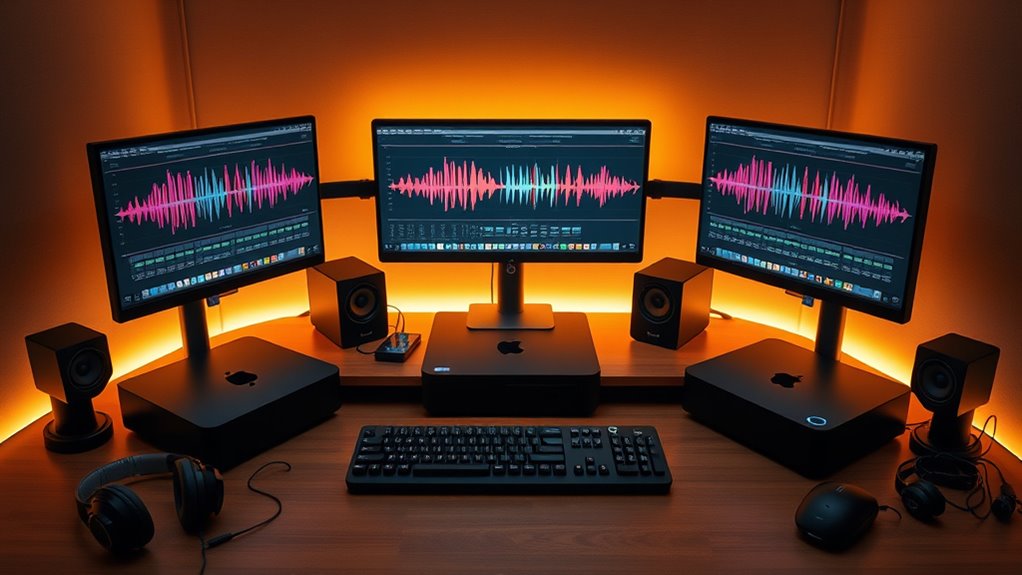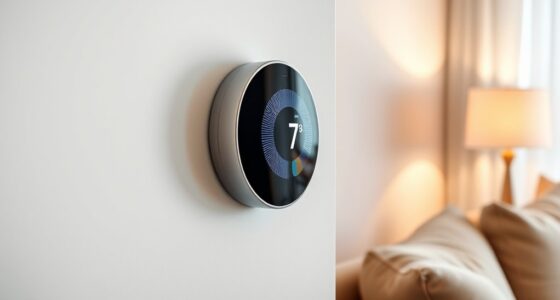If you’re looking for the best Mac mini models for your home studio in 2025, I recommend the Apple 2024 Mac mini with M4 Pro for intense creative tasks, and the base M4 model with 16GB RAM for versatility. The M4 with 24GB RAM and 512GB SSD suits demanding workflows, while the M4 with 256GB SSD offers a budget-friendly option with strong performance. Keep exploring to find the perfect fit for your setup.
Key Takeaways
- Opt for models with M4 or M4 Pro chips for optimal performance with demanding audio and multimedia workflows.
- Prioritize Mac minis with at least 16GB RAM and multiple Thunderbolt/USB-C ports for expandability and peripheral connectivity.
- Choose models supporting up to three high-resolution displays, including 6K or 8K, for flexible visual setups.
- Consider units with ample SSD storage (512GB or more) to handle large audio files and project data seamlessly.
- Focus on compact, durable designs with accessible ports suitable for tight home studio spaces.
Apple 2024 Mac mini Desktop Computer with M4 Chip
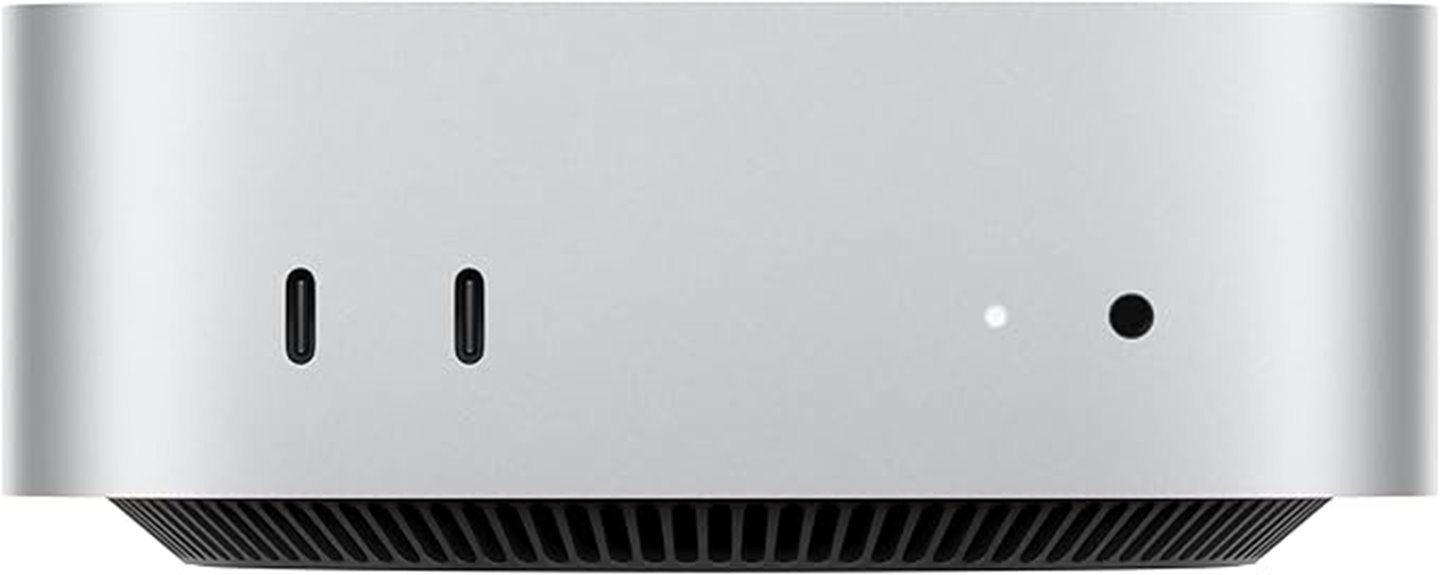
If you’re looking for a compact yet powerful desktop for your home studio in 2025, the Apple 2024 Mac mini with the M4 chip is an excellent choice. Its small footprint, just 5×5 inches, makes it easy to fit next to your monitor or anywhere else. Powered by the M4 chip with a 10-core CPU and GPU, it offers snappy, fluid performance perfect for demanding creative tasks. With 16GB of unified memory and a 512GB SSD, it handles multitasking effortlessly. Plus, its multiple ports, seamless macOS integration, and Apple ecosystem compatibility make it ideal for studio work, ensuring both power and convenience in a compact package.
Best For: creative professionals and home studio users seeking a compact, powerful, and seamless desktop experience with advanced Apple ecosystem integration.
Pros:
- Compact size fits easily next to monitors or in tight spaces
- Powerful M4 chip with 10-core CPU and GPU delivers fast, fluid performance
- Seamless integration with macOS, iPhone, and iPad enhances productivity and convenience
Cons:
- Limited upgrade options due to compact design and integrated hardware
- Higher initial cost compared to some traditional desktops with similar specs
- Limited ports on the back may require additional hubs for extensive connectivity
Apple 2024 Mac mini Desktop Computer with M4 Pro chip
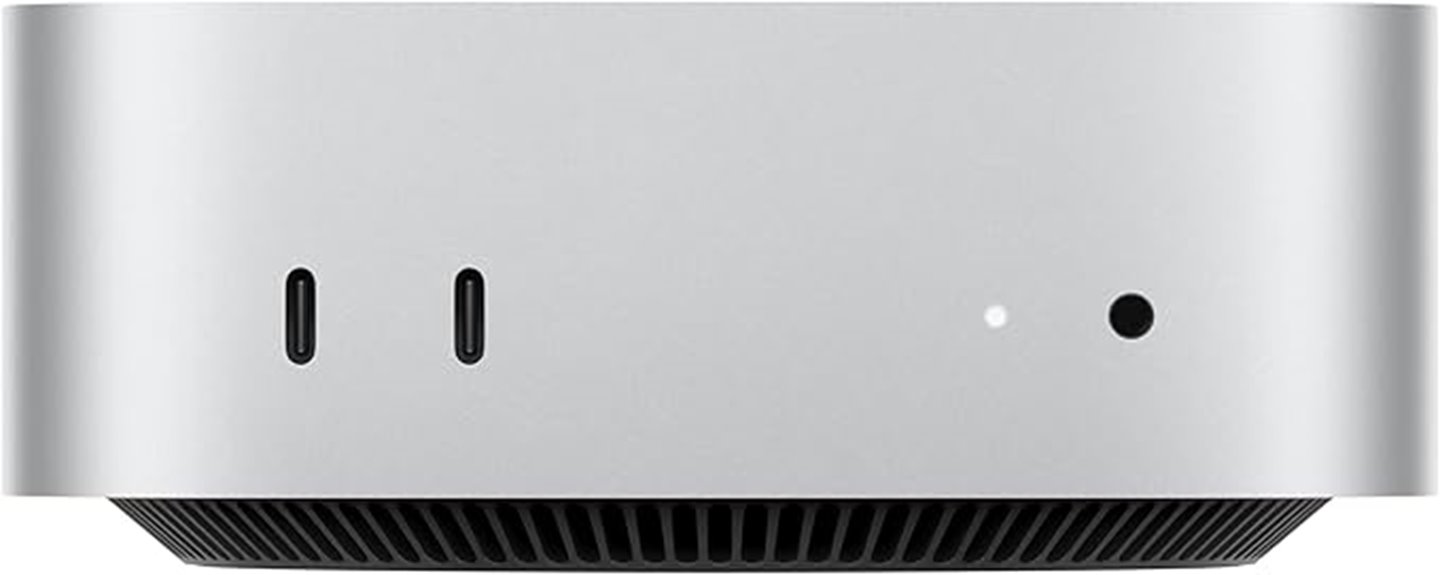
The Apple 2024 Mac mini with the M4 Pro chip stands out as an ideal choice for creative professionals seeking a compact yet powerful home studio workstation. Its sleek, lightweight design (just 5×5 inches) fits easily next to any monitor, conserving space. The M4 Pro’s 12-core CPU and 16-core GPU deliver around 20% faster performance than previous models, supporting demanding tasks like video editing and 3D rendering. It supports up to three high-resolution displays, offers fast connectivity with Thunderbolt 5 and HDMI, and runs quietly with efficient cooling. While lacking USB-A ports, it excels in power, size, and energy efficiency for creative workflows.
Best For: creative professionals and tech enthusiasts seeking a compact, powerful desktop for demanding tasks like video editing, 3D rendering, and multitasking.
Pros:
- Compact, space-efficient design fits easily next to monitors
- Powerful M4 Pro chip with fast CPU and GPU performance
- Supports up to three high-resolution displays for multitasking
Cons:
- No USB-A ports; requires adapters or hubs for peripherals
- Non-upgradable RAM and storage in base models
- Power button placement on the bottom may be less intuitive
Apple Mac mini Desktop Computer with M4 Chip, 16GB Memory, 256GB SSD
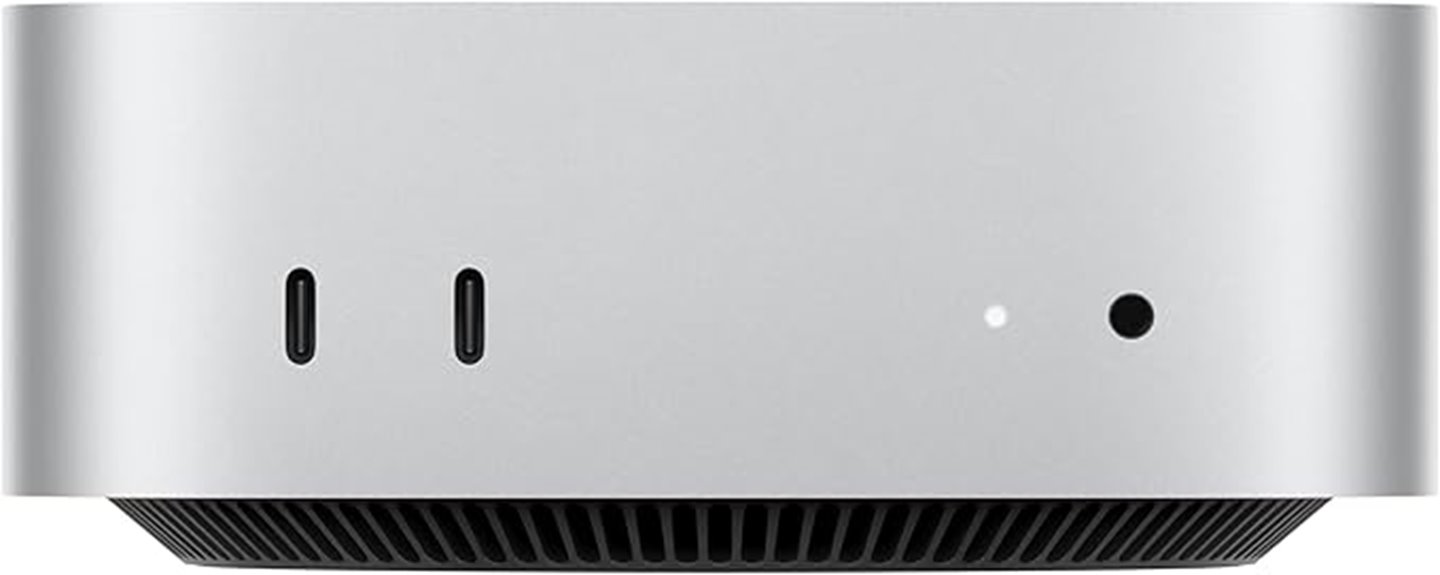
Designed for creatives who need powerful performance in a compact form, the Apple Mac mini with M4 chip, 16GB memory, and 256GB SSD delivers impressive capabilities for home studio workstations. Its small footprint—just 5 inches square and 1.5 pounds—fits easily next to your monitors. Powered by the M4 chip’s 10-core CPU and GPU, it handles audio editing, recording, and multitasking with ease. Support for up to three displays, fast Thunderbolt 4, HDMI, and extensive connectivity make it versatile. The macOS optimization and AI enhancements guarantee smooth workflow, making this mini a robust, space-saving choice for serious creators.
Best For: creatives and professionals seeking a compact, powerful desktop for audio editing, recording, multitasking, and home studio setups.
Pros:
- Compact design fits easily next to monitors, saving space
- Powerful M4 chip with 10-core CPU and GPU for demanding creative tasks
- Supports up to three displays and extensive connectivity options
Cons:
- No USB-A ports, requiring adapters for certain peripherals
- Power button placement at the bottom may be less intuitive
- Base model’s 16GB memory might limit intensive workflows without upgrades
Apple Mac mini Desktop Computer with M4 Chip, 24GB Memory, 512GB SSD
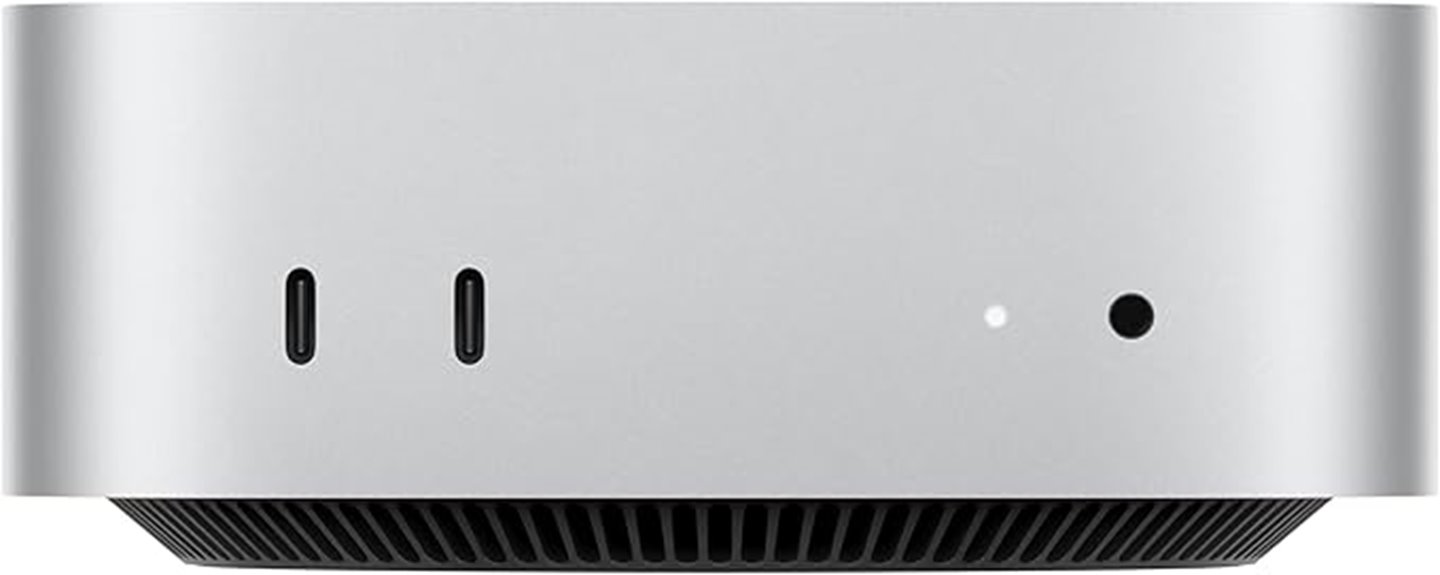
For home studio professionals seeking powerful performance in a compact form, the Apple Mac mini with the M4 chip, 24GB of memory, and 512GB SSD stands out as an ideal choice. Its sleek aluminum design measures just 5 inches square and weighs only 1.5 pounds, fitting easily next to monitors. Powered by the 10-core M4 chip, it handles demanding tasks like video editing, 3D rendering, and music production smoothly. With support for up to three displays and fast connectivity options, it’s perfect for multitasking. Although it lacks USB-A ports and has a non-upgradable RAM, its performance-to-price ratio makes it a compelling option for home studios.
Best For: home studio professionals and creative users seeking a compact, powerful, and energy-efficient desktop for demanding multimedia workflows.
Pros:
- Compact design with a sleek aluminum finish, ideal for space-constrained environments.
- Powerful M4 chip with 10-core CPU and GPU, supporting demanding creative tasks smoothly.
- Supports up to three external displays and offers fast connectivity options like Thunderbolt 4 and Wi-Fi 6E.
Cons:
- Lacks USB-A ports, requiring adapters or hubs for legacy peripherals.
- Non-upgradable RAM and storage, limiting future expandability.
- Power button placement on the bottom may be less intuitive to locate.
Factors to Consider When Choosing a Mac Mini for Home Studio Workstations
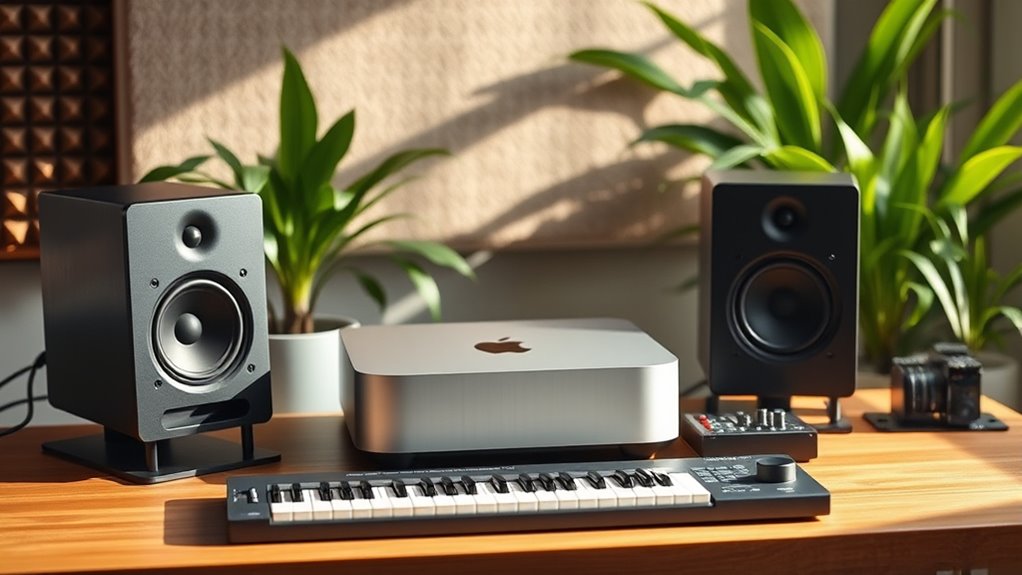
When choosing a Mac Mini for your home studio, I consider several key factors to get the best fit. You need to think about processing power, storage, and memory options to handle your projects smoothly. Additionally, compatibility with your software and external display requirements are vital for a seamless workflow.
Processing Power Needs
Choosing the right Mac mini for your home studio hinges heavily on its processing power, which directly impacts how smoothly you can run demanding audio, video, and music production software. A more powerful CPU with higher core counts, like 10 or 12 cores, ensures faster rendering and less lag during real-time editing. Additionally, a robust GPU and Neural Engine can accelerate video effects and AI-driven workflows, boosting efficiency. Noticeable CPU performance boosts of 20% or more over previous models mean better multitasking and handling complex calculations. Investing in a Mac mini with sufficient processing power not only improves current project performance but also future-proofs your setup for expanding creative needs. This ensures a seamless experience, even with resource-intensive applications running simultaneously.
Storage and Memory Options
Selecting the right storage and memory options is essential for guaranteeing your Mac mini can handle the demands of a home studio setup. I recommend at least 16GB of RAM to smoothly run multiple audio tracks, plugins, and video editing tasks simultaneously. For storage, choose a capacity that matches your project scope; 256GB works for light use, but 1TB or more is better for large sample libraries and high-resolution media. Faster SSDs, such as 512GB or higher, markedly improve load times and data transfer speeds, which are critical for real-time editing. Some Mac mini models offer configurable RAM and storage, so planning for future upgrades or external drives can help you stay flexible. Balancing memory and storage ensures smooth performance without overspending, keeping your workflow efficient.
Connectivity Requirements
To build an efficient home studio workstation with a Mac mini, it’s crucial to guarantee it has enough ports to connect all your gear seamlessly. Make sure it includes Thunderbolt, HDMI, and USB-C ports to connect audio interfaces, MIDI controllers, and external drives simultaneously. If you use multiple monitors, confirm the Mac mini supports multiple external displays for easier mixing and editing. High-speed Ethernet or Wi-Fi 6E support is essential for fast data transfer and streaming large files without lag. Check for headphone jacks and audio output options to connect monitors, headphones, and recording equipment directly. Ultimately, consider adapters or hubs if some ports are missing, ensuring expandability for future equipment and a flexible, clutter-free setup.
Compatibility With Software
Ensuring your Mac mini is compatible with your home studio software is vital for a smooth workflow. First, check that your digital audio workstations (DAWs) and creative apps are compatible with the macOS version on your Mac mini, especially as updates can change support. It’s also essential to verify that your software supports Apple Silicon, like the M4 or M4 Pro chips, for peak performance and stability. Make sure your essential plugins, virtual instruments, and third-party extensions are updated and optimized for Apple Silicon to prevent compatibility issues. Additionally, confirm that hardware acceleration features for video and audio processing are supported by the Mac mini’s GPU and media engines. Finally, ensure your peripherals, such as audio interfaces and MIDI controllers, have proper driver support for seamless integration.
External Display Support
When setting up a home studio workstation with a Mac mini, supporting multiple external displays can considerably enhance your workflow. It is crucial to confirm that the Mac mini can handle up to three high-resolution monitors simultaneously. Look for models supporting resolutions like 6K at 60Hz or even 8K at 60Hz to ensure sharp visuals. Check the available video output ports—Thunderbolt 4 and HDMI are common—and verify their compatibility with your monitors and adapters. Additionally, consider the supported video formats and HDR capabilities, especially if you’re working with high-dynamic-range content. Finally, verify the GPU and media engines can manage your chosen resolutions and color depths, so your creative projects remain accurate and smooth without performance issues.
Port Accessibility and Placement
Choosing a Mac mini for your home studio means paying close attention to port accessibility and placement, as these factors directly impact your workflow. Proper port placement ensures you can easily connect audio interfaces, external drives, and peripherals without clutter or obstruction. Front-facing USB-C ports are especially convenient for quick connections to MIDI controllers or storage devices, reducing cable mess. Rear ports like Thunderbolt and HDMI should be positioned to minimize cable strain and keep your workspace tidy. Keep in mind that the power button’s location, often at the bottom, might be less accessible if your Mac Mini is in a tight spot. Additionally, the lack of USB-A ports means you’ll likely need adapters or hubs, which can affect your connection ease during busy sessions.
Frequently Asked Questions
How Does the M4 Pro Chip Improve Audio Processing?
The M4 Pro chip boosts audio processing by delivering faster, more efficient performance, which means I experience lower latency and smoother recording sessions. Its advanced neural engine handles complex audio algorithms seamlessly, allowing me to run multiple plugins without hiccups. Plus, the improved integrated hardware accelerates real-time effects, making my workflow more efficient. Overall, the M4 Pro makes my home studio setup more responsive and reliable, enhancing my creative process.
Which Mac Mini Models Offer the Best Upgrade Potential?
Imagine your workflow as a river, flowing smoothly with potential for new tributaries. The Mac Mini models with the M4 Pro chip and upgradable RAM and storage offer the best upgrade potential. I’d choose a model that lets you expand memory and storage easily, so your setup can grow with your projects. These models act like fertile ground, ready to nurture your creative ideas for years to come.
Are There Specific Ports Ideal for Home Studio Gear?
Absolutely, I look for ports that support my studio gear. USB-C and Thunderbolt ports are vital because they handle high-speed data transfers and connect to audio interfaces, MIDI controllers, and external drives seamlessly. An Ethernet port is also indispensable for stable internet streaming or large file transfers. Additionally, having an audio output port helps connect monitors and headphones directly. These ports guarantee my setup runs smoothly and efficiently.
How Does Thermal Performance Impact Long Recording Sessions?
Ever wondered if thermal performance really affects your long recording sessions? It does, and it’s essential I tell you. When a Mac Mini overheats, it throttles performance, risking crashes or audio glitches just when you’re in the zone. Good thermal design keeps your system cool, ensuring smooth, uninterrupted recordings. So, don’t overlook cooling solutions—they’re the silent heroes that keep your creative flow steady and your sessions flawless.
Is External GPU Support Available for Mac Mini Models?
Yes, external GPU support is available for certain Mac Mini models, especially the newer ones with Thunderbolt 3 or 4 ports. I’ve found that connecting an eGPU markedly boosts graphics performance, which is great for demanding tasks like video editing or 3D rendering. Just make sure your Mac Mini has the compatible hardware and software updates. This way, you can maximize your workstation’s power without sacrificing compactness.
Conclusion
No matter which Mac mini you choose, it’s clear that the right model can make all the difference in your home studio. Think of it as finding the missing piece to your puzzle—once it clicks, your workflow becomes smoother and more efficient. So, don’t rush—pick the one that fits your needs and budget. After all, a well-chosen Mac mini can turn your creative dreams into reality.
